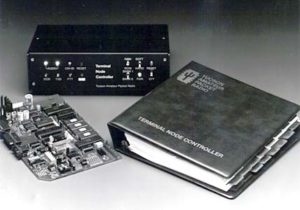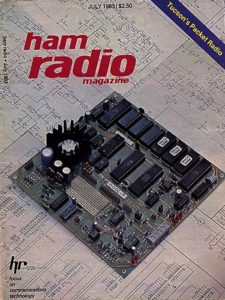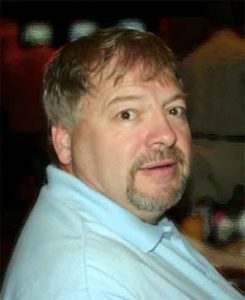1980s
First TAPR Packet QSO
By Den Connors, KD2S
(from PSR #1, July 1982, page 7)
After several hours of transmission of test packets, Lyle Johnson, WA7GXD, successfully initiated the first Amateur packet radio contact with all-American hardware and software, using the Tucson Amateur Packet Radio Terminal Node Controller (TNC), at 9:12pm PST, June 25th, 1982. At the receiving end was Den Connors, KD2S, who was co-located with Lyle at the WA7GXD station. The tests were conducted at 146.55MHz in the Amateur two-meter band, with both stations sending plain-text ASCII messages.
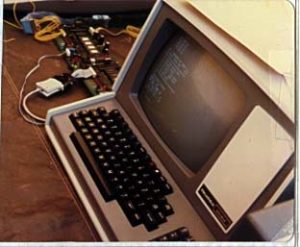 Photo of a Heath H-89 terminal and a TAPR Alpha TNC. Photo shows the test setup before the group loaded it into the cars to head for the hotel to share TAPR’s work with others at the 1982 ARRL SW Division convention in San Diego. You’ll notice the some what Olive Drab color of the flat surface and the line that looks like the edge of a table is really the seam in the tarpaulin. The group tented near the beach while at the conference.
Photo of a Heath H-89 terminal and a TAPR Alpha TNC. Photo shows the test setup before the group loaded it into the cars to head for the hotel to share TAPR’s work with others at the 1982 ARRL SW Division convention in San Diego. You’ll notice the some what Olive Drab color of the flat surface and the line that looks like the edge of a table is really the seam in the tarpaulin. The group tented near the beach while at the conference.
The two-way contact lasted for about one hour, during which time several different experiments were conducted to determine optimal selection of components for the TNC modem amplifier-filter set.
Within twelve hours of the first QSO, the experiment was repeated over a distance of about twenty miles, from one side of Tucson to the other, under conditions which were as bad as less than S1, with total success. Tucson’s first packet rag-chew lasted about 45 minutes, with different antenna and signal-level combinations tried by Lyle and Den.
Also at the first transmissions were Marc Chamberlin, WA7PXW, the TAPR Software Chairman, Margaret Morrison, KC7MA, the TAPR Publicity Chairman, and Heather Johnson, N7DZU, a member of the Publicity Committee.
These tests culminated hundred of hours of effort on the part of WA7GXD, who has spearheaded the design of the TNC as Hardware Chairman. Completion of modifications to the on-board modem next week will allow Lyle to release a final version of the TNC to a local Computer-Assisted Design firm for the artwork and construction of the TAPR TNC Beta boards, which are slated for an August release.
1982 Core Group
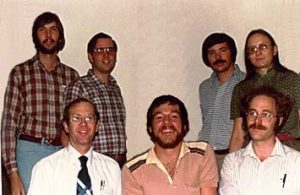 A photo of the key players in TAPR that made possible the activities of the organization in its early years.Front Row (L-R): Chuck Green, N0ADI (BoD); Mark Baker (BoD/Secretary); Dan Morrison, KB3UC (Beta Coordinator). Back Row (L-R): Marc Chamberlin, WA7PXN (BoD); Lyle Johnson, WA7GXD (BoD/VP); Den Connors, KD2S (BoD/Pres); Margaret Morrison, KC7MA (Software).
A photo of the key players in TAPR that made possible the activities of the organization in its early years.Front Row (L-R): Chuck Green, N0ADI (BoD); Mark Baker (BoD/Secretary); Dan Morrison, KB3UC (Beta Coordinator). Back Row (L-R): Marc Chamberlin, WA7PXN (BoD); Lyle Johnson, WA7GXD (BoD/VP); Den Connors, KD2S (BoD/Pres); Margaret Morrison, KC7MA (Software).
First TAPR Meeting (1982)
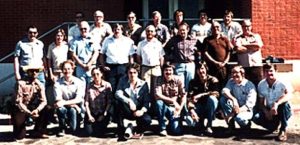 Picture of the groups first public meeting at the University of Arizona in February 1982. TAPR had a meeting before that, in December 1981, well attended, at the big telescope on top of Kitt Peak.Front Row (L-R): Elio Zambrano, WB7ESQ, Dan Morrison, KB3UC, Margaret Morrison, KC7MA, Dave McClain, N7AIG, Den Connors, KD2S, Marc Chamberlin, WA7PXN, John McClain, WB7CKY, Ron Bates, AG7H.
Picture of the groups first public meeting at the University of Arizona in February 1982. TAPR had a meeting before that, in December 1981, well attended, at the big telescope on top of Kitt Peak.Front Row (L-R): Elio Zambrano, WB7ESQ, Dan Morrison, KB3UC, Margaret Morrison, KC7MA, Dave McClain, N7AIG, Den Connors, KD2S, Marc Chamberlin, WA7PXN, John McClain, WB7CKY, Ron Bates, AG7H.
Second Row (L-R): Richard Giebner, WA7AEG, Dan Giebner, KA7FJR, Howard Sherrow, WB7SBX, John Bryson, N7DME, Dave, WB7OBG, John Cerniglia, N9AGB, Dan Smith, WB7VMO, Jack Hanny, KB7CH.
Back Row (L-R):Bill Gage, WA7FDN, Ken Macleish, W7TX, Lyle Johnson, WA7GXD, Chuck Green, N0ADI, Mike Roedel, KB7XP, Craig Carnahan, N7CYF, Mark Baker.
TAPR TNC-1 (1982-83)
Photo of the TNC-1 kit. It included the parts, box, and assembly manual. This kit set the standard for future TAPR kits.
TNC-1 Board
Article on the TNC-1 appeared in the Ham Radio Magazine July 1983.
Black Thursday
By Lyle Johnson, WA7GXD
(from PSR #3, December 1982, page 3)
Everything was running on schedule. The Beta parts had all arrived within two or three days of deadline, the assembly facilities were busily stuffinh the PC boards. All looked well.
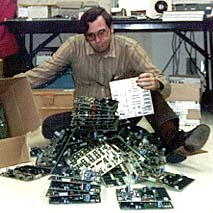 Then a disturbing quality was noted on the PC boards. They weren’t taking solder very well. A lot of rework was necessary, and when the rework was being done, the solderability problem got worse. By now it was 7 December, Pearl Harbor Day. It was agreed that the PC house would get us first boards ASAP (they were all due on the 7th) so we could get rolling with testing.
Then a disturbing quality was noted on the PC boards. They weren’t taking solder very well. A lot of rework was necessary, and when the rework was being done, the solderability problem got worse. By now it was 7 December, Pearl Harbor Day. It was agreed that the PC house would get us first boards ASAP (they were all due on the 7th) so we could get rolling with testing.
More delays. More problems. More calls. The solderability of the boards was becoming a major production setback. The chief engineer at the PC fabrication facility was dispatched to one of the two assembly points (both were experiencing the same problems) to attempt to find the cause of, and hopefully a solution to, this problem.
Late Wednesday afternoon a batch of 19 Beta Boards were delivered to the anxious checkout crew. Immediately Lyle, WA7GXD, and Pete, WB9FLW, (later joined by Den, KD2S and Dan KV7B) set to work on the boards. test Number One was to apply power to the boards with no socketed ICs in place to ensure that the voltage regulators were working — we didn’t want to fry $158 worth of chips! All 19 boards passed with no problems.
The board were then loaded with ICs along with some calibration/checkout software which was provided by Margaret, KV7D. The first board passed all tests with flying colors. The night passed. By 2:00am Thursday, December 9th, we knew we had a severe problem — only three Beta Boards out of fifteen tester were working!
See the article for the whole disaster recovery story!
TAPR Announces the TNC-2
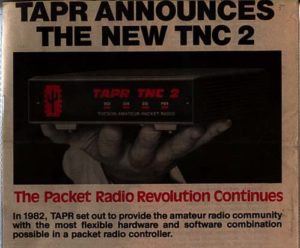 (from PSR #15, May 1985, page 4)
(from PSR #15, May 1985, page 4)
In 1982, TAPR embarked on development of a packet radio Terminal Node Controller (TNC) that was to become the standard of the industry. Indeed, the TAPR TNC (now called TNC-1) has become the controller of choice by the majority of the world Amateur packet community.
When it became apparent that industry was moving into the Amateur packet marketplace, TAPR set out to design a low-cost TNC that would meet the needs of the majority of Amateur packet radio operators. A TNC that would be an evolutionary step in the growth of the mode. A unit following in the footsteps of the TNC-1, offering virtually the same performance and capability.
If the reaction at the 1985 Dayton Hamvention is any measure, TNC-2 is destined to set a new standard in the Amateur packet arena.
(more in PSR issue #15)
1990s
TAPR on the Internet
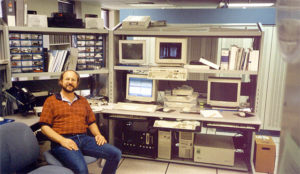 In 1992, TAPR joined the Internet. Bob Nielsen, W6SWE, with the assistance of David Dodell, WB7TPY, created an e-mail distribution system to replace the CompuServe message boards that the organization had been using since the mid-80’s. In 1993, Lou Nigro, KW7H, setup a new system that supported the organizations first e-mail lists and implemented a software library file request via e-mail. We received so much activity before the end of the year that we crashed the mail server and the host that was supporting. Greg Jones, WD5IVD, relocated the system temporaily to a commercial site while TAPR looked for a new permanent site. In 1994, Lee Ziegenhals, N5LYT, volunteered to assist in hosting and managing the TAPR.ORG system. Lee supported TAPR in the role of Internet coordinator between 1994 and 2005 (11 years), providing access to highspeed, commercial connectivity and expertise in managing the site during various moves of location, operating systems, crashes and recovery, and all the rest that this position is responsible. The TAPR.ORG system has been critical in the success of the organization since it was established in 1994 and Lee has be a key member in making that possible. The photo (right) shows Lee sitting in the network control room where TAPR.ORG was hosted. The computers are located under the keyboard (dead center of the photo). One system is the main server and the second system runs Lryis and is our secure web server.
In 1992, TAPR joined the Internet. Bob Nielsen, W6SWE, with the assistance of David Dodell, WB7TPY, created an e-mail distribution system to replace the CompuServe message boards that the organization had been using since the mid-80’s. In 1993, Lou Nigro, KW7H, setup a new system that supported the organizations first e-mail lists and implemented a software library file request via e-mail. We received so much activity before the end of the year that we crashed the mail server and the host that was supporting. Greg Jones, WD5IVD, relocated the system temporaily to a commercial site while TAPR looked for a new permanent site. In 1994, Lee Ziegenhals, N5LYT, volunteered to assist in hosting and managing the TAPR.ORG system. Lee supported TAPR in the role of Internet coordinator between 1994 and 2005 (11 years), providing access to highspeed, commercial connectivity and expertise in managing the site during various moves of location, operating systems, crashes and recovery, and all the rest that this position is responsible. The TAPR.ORG system has been critical in the success of the organization since it was established in 1994 and Lee has be a key member in making that possible. The photo (right) shows Lee sitting in the network control room where TAPR.ORG was hosted. The computers are located under the keyboard (dead center of the photo). One system is the main server and the second system runs Lryis and is our secure web server.
The first TAPR web pages were created by Howie Goldstien, N2WX, who created a basic home page and several pages on packet radio that were hosted on his corporate site (Infomotion) in 1995. Some of that content still apperas on the current TAPR.ORG site. Later in 1995, the pages on Infomotion were relocated to the TAPR.ORG site to be hosted. Greg Jones, WD5IVD, expanded upon Howie’s first site and TAPR added streaming audio content to page from interviews and conferences. Also in 1995, Bob Nielsen, W6SWE, transfered TAPR’s extensive disk-based software library onto TAPR.ORG for FTP access. Till then to get TAPR or packet-related software you purchased a floppy disk from the office or at a conference. The software library on TAPR.ORG to this day remains active and provides access to software for hundreds of thousands of hams and hobbist each year. The TAPR.ORG web site underwent a major overhaul in 1997, when Greg Jones, WD5IVD, restrucuted the site.
In 2005, the TAPR.ORG site was relocated to a co-lo facility. Also in 2005, Greg Jones, WD5IVD, again took up the multi-week task of migrating the web content. This time moving from the frames/tables done in 1997 to cascading style sheets that were database driven.
TAPR Office Relocates
Reprinted from PSR #52, 1993 and #53, 1994
 During the summer (1993), Heather Johnson submitted her resignation as TAPR office manager. There are many reasons for this request, but the basic ones are the fact that Heather has kept the TAPR office going for many years now and wants a change and she wants to spend more time with Lyle which she has trouble doing with the hours she is putting in running the office.With a change impending, the Board began to think about ways to lessen the impact of the move now and again in the future. We have been extremely fortunate to have Heather doing this function, but it cannot be depended on to have the sales office in the same place year after year. With this in mind several points became important:
During the summer (1993), Heather Johnson submitted her resignation as TAPR office manager. There are many reasons for this request, but the basic ones are the fact that Heather has kept the TAPR office going for many years now and wants a change and she wants to spend more time with Lyle which she has trouble doing with the hours she is putting in running the office.With a change impending, the Board began to think about ways to lessen the impact of the move now and again in the future. We have been extremely fortunate to have Heather doing this function, but it cannot be depended on to have the sales office in the same place year after year. With this in mind several points became important:
- Future flexibility in office location and office personnel.
- Continue to provide a strong membership services interface.
- Improve office efficiency while cutting expenses.
 The TAPR troops descended on Tucson during the week of December 13th, 1993, in order to close and pack the TAPR office at the Johnson’s. This brought to an end many years of dedicated service by Heather Johnson. After packing the office and cleaning the storage shed, we had 36 boxes of an average of 40+ pounds each being shipped. A lot of stuff! It was a lot of work by all. The Texas-based office opened again January 11th, with a record number of calls. The office received 80+ calls the first day. Dorothy, our new office manager, had her trial by fire that first day.The Denton office later relocated in August of 2001 to Richardson, Texas, with Laura Koster being the current office manager.
The TAPR troops descended on Tucson during the week of December 13th, 1993, in order to close and pack the TAPR office at the Johnson’s. This brought to an end many years of dedicated service by Heather Johnson. After packing the office and cleaning the storage shed, we had 36 boxes of an average of 40+ pounds each being shipped. A lot of stuff! It was a lot of work by all. The Texas-based office opened again January 11th, with a record number of calls. The office received 80+ calls the first day. Dorothy, our new office manager, had her trial by fire that first day.The Denton office later relocated in August of 2001 to Richardson, Texas, with Laura Koster being the current office manager.
TAPR Annual Meeting and ARRL DCC Merge
In 1994, plans were begun to merge that TAPR annual meeting and ARRL Digital Communications Conference (DCC). The DCC, originally named the Computer Networking Conference, had seen lowering attendance and many of the same people were attending both conferences. Two years earlier, TAPR had defined an agreement with the ARRL to distirbute all back issues of the DCC and CNC proceedings. In 1995, TAPR hosted the ARRL Digital Communications Conference in Arlington, Texas. After the 1995 DCC conference, a memorandium of understanding between ARRL and TAPR was signed mergering the two conferences into the TAPR/ARRL Digital Communications Conference that placed TAPR into the role of conference manager. Also, the policy of moving the conference throughout the US from East to West over a three year cycle was established.Today the ARRL and TAPR Digital Communications Conference is an international forum for radio amateurs to meet, publish their work, and present new ideas and techniques. Presenters and attendees have the opportunity to exchange ideas and learn about recent hardware and software advances, theories, experimental results, and practical applications.
Topcis vary from year to year and reflect the changing nature of research and development to implementation within amateur radio. Early in the conference the focus was on packet radio, message systems, and the Internet, in the mid 90’s the focus changed to digital signal processing and APRS, in the late 90’s spread specturm communications began to emerge as a new topic. The conference, through this merger, has stayed a vibrant and meangingful yearly conference.
TAPR and AMSAT form joint DSP-93 Project
Spread Specturm Initiative
APRS and GPS Take Off
2000s
Past Presidents
 Lyle Johnson, WA7GXD
Lyle Johnson, WA7GXD
1983 – 1987, 1990
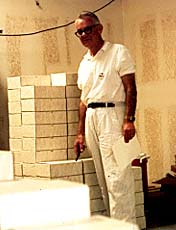 Andy Freeborn, N0CCZ
Andy Freeborn, N0CCZ
1988 – 1989
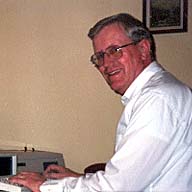 Bob Nielsen, W6SWE
Bob Nielsen, W6SWE
1991 – 1992
 Greg Jones, WD5IVD
Greg Jones, WD5IVD
1993 – 2000
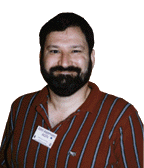 John Ackermann, N8UR
John Ackermann, N8UR
2000 – 2005
